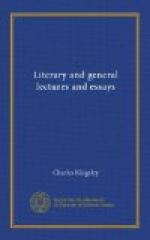Mrs. Jameson acknowledges her great obligations to M. Rio; and all students of art must be thankful to him for the taste, learning, and earnest religious feeling which he has expended on the history of the earlier schools of painting. An honest man, doubtless, he is; but it does not follow, alas! in this piecemeal world, that he should write an honest book. And his bigotry stands in painful contrast to the genial and comprehensive spirit by which Mrs. Jameson seems able to appreciate the specific beauties of all schools and masters. M. Rio’s theory (and he is the spokesman of a large party) is, unless we much misjudge him, this—that the ante-Raphaelic is the only Christian art; and that all the excellences of these early painters came from their Romanism; all their faults from his two great bugbears—Byzantinism and Paganism. In his eyes, the Byzantine idea of art was Manichean; in which we fully coincide, but add, that the idea of the early Italian painters was almost equally so: and that almost all in them that was not Manichean they owe not to their Romanism or their asceticism, but to their healthy layman’s common sense, and to the influence of that very classical art which they are said to have been pious enough to despise. Bigoted and ascetic Romanists have been, in all ages, in a hurry to call people Manicheans, all the more fiercely because their own consciences must have hinted to them that they were somewhat Manichean themselves. When a man suspects his own honesty, he is, of course, inclined to prove himself blameless by shouting the loudest against the dishonesty of others. Now M. Rio sees clearly and philosophically enough what is the root of Manicheanism—the denial that that which is natural, beautiful, human, belongs to God. He imputes it justly to those Byzantine artists who fancied it carnal to attribute beauty to the Saviour or to the Virgin Mary, and tried to prove their own spirituality by representing their sacred personages in the extreme of ugliness and emaciation, though some of the specimens of their painting which Mrs. Jameson gives proves that this abhorrence of beauty was not so universal as M. Rio would have us believe. We agree with him that this absurdity was learned from them by earlier and semi-barbarous Italian artists, that these latter rapidly escaped from it, and began rightly to embody their conceptions in beautiful forms; and yet we must urge against them, too, the charge of Manicheanism, and of a spiritual eclecticism also, far deeper and more pernicious than the mere outward eclecticism of manner which has drawn down hard names on the school of the Caracci.




